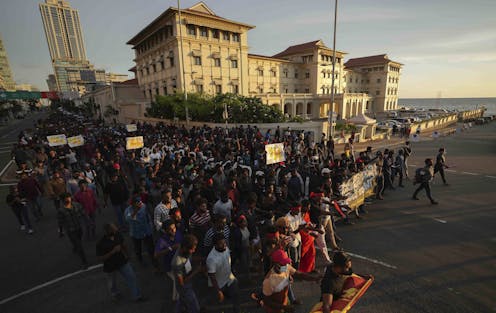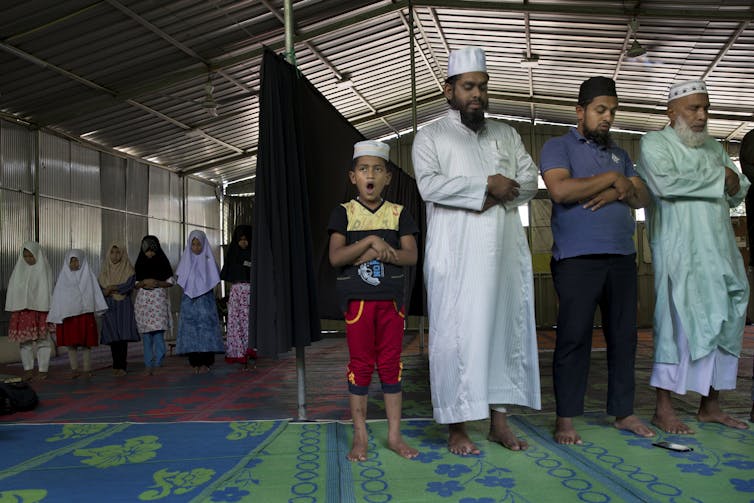Sri Lanka's protests show a fragile unity – for now
The country has a long history of ethnic and religious conflict, but the worst economic crisis in decades has brought protesters together.

Sri Lanka is facing its worst economic crises since winning independence from Britain in 1948. Inflation is at an all-time high and protests are spreading around the country.
Most public anger is directed toward President Gotabaya Rajapaksa and his brother, Prime Minister Mahinda Rajapaksa. Critics point to the Rajapaksas’ poor handling of the COVID-19 crisis, and “Gota out” signs demanding their resignations are seen across the country.
Protesters come from all ethnicities and all religions. This seeming unity is notable in Sri Lanka, which has been deeply divided for decades. The country has a violent history of ethnic and religious conflict, and of scapegoating minorities. In recent years, that has been particularly true of Muslims, who make up about 10% of the population. As a historian of religion who focuses on Sri Lanka, I have studied Muslims’ precarious position in Sri Lankan society amid growing discrimination.
Civil war
Traditionally, Sri Lanka has been divided into three major ethnic groups: the Sinhalese, who make up 74% of the population and are mostly Buddhists; the Tamils, about 15%, most of whom are Hindu; and Muslims, who are descendants of Middle Eastern traders and mostly speak the Tamil language.
In 1983 a civil war broke out between the Sri Lankan government and Tamil separatists that lasted until 2009. Violent tensions between the island’s two biggest groups had existed for years, with the Sinhalese majority believing Tamils had received preferential treatment under the British. After independence, the situation reversed: for example, Sinhala became the only official language, meaning that Tamil-speaking Sri Lankans lost jobs in the public sector.
The constitution assures the religious freedom of all, but Buddhism is also given a special status. It states, “The Republic of Sri Lanka shall give to Buddhism the foremost place and accordingly it shall be the duty of the State to protect and foster” the faith.
The war caused the deaths of at least 100,000 people, including tens of thousands of civilians, though estimates vary. As many as 100,000 Tamils might still be displaced. Both sides were accused of war crimes, including at the end of the war, when Mahinda Rajapaksa – now prime minister – was president, and his brother Gotabaya, now president, was secretary of defense.
Government officials deny abuses, and have tried to block the United Nations’ ongoing investigation.
New tensions
After the war the country’s third-largest ethnic group, Muslims, became the new target for Sinhalese nationalists, who claimed that Muslims had both economic and ideological ties with the Middle East. A hardline Buddhist group called the Bodu Bala Sena encouraged anti-Muslim sentiment, and accused halal food industries of sponsoring international terrorism.
During Easter 2019, local Muslim terrorists inspired by the Islamic State carried out an attack killing over 250 people in several Christian churches and hotels. This was the worst attack in Sri Lanka against civilians since the civil war ended in 2009, and prompted more discrimination against Muslim citizens
Buddhist nationalists supported Gotabaya Rajapaksa’s election as president in 2019. Since then, the government has proposed plans to ban full-face veils in public and to shut down many Islamic schools. During the pandemic, the government forced people who died from COVID-19 to be cremated, in violation of traditional Islamic funeral ceremonies.
In 2021, Amnesty International released an 80-page report about anti-Muslim prejudice in the country. The researchers urged Sri Lanka’s government to repeal the Prevention of Terrorism Act, which has been used to target prominent Muslim activists.

Muslims have also expressed fear of land grabs, which Rauff Hakeem, the leader of the largest Muslim political party, the Sri Lankan Muslim Congress, has called his community’s biggest concern. Land seizures by the army have been major concerns for Tamils, as well.
Unity or division?
For now, ethnic tensions appear to be on hold. The common foe is the Rajapaksa family, as protesters demand that the president and prime minister step down.

An official spokesman from the Sri Lankan Muslim Congress, who requested to remain anonymous, told me that Muslims’ participation in protests has “surprised the government. Christians who came in thousands after Easter Sunday mass and the clergy of Buddhists in thousands all over the island came together under one banner as Sri Lankans. Not as Sinhalese, Tamil, Muslim or Christians.”
Yet Muslims are often stereotyped as wealthy. Given Sinhalese nationalists’ past accusations that Muslims have suspect economic ties with the Middle East, some, including contacts of mine inside the country, have voiced concern that leaders could channel ethnic tensions to blame minorities for the country’s economic downfall. Pro-government social media campaigns have frequently targeted minorities like Tamils and Muslims.
“The current protest movement’s focus on the commonality of experience, while understandable, does little to reassure Tamils and Muslims that they are safe from ethnic scapegoating for the country’s economic woes,” Mario Arulthas, a doctoral candidate studying Tamils and nationalism at SOAS University of London, wrote in a recent column. Such scapegoating is “a tactic the state has historically used as a distraction during times of crisis, resulting in pogroms against these communities.”
As Sri Lanka goes forward, its citizens will confront not only the aftermath of the economic crisis, but these legacies of suspicion among ethnic groups.
[3 media outlets, 1 religion newsletter. Get stories from The Conversation, AP and RNS.]
Andreas Johansson does not work for, consult, own shares in or receive funding from any company or organization that would benefit from this article, and has disclosed no relevant affiliations beyond their academic appointment.
Read These Next
How to reduce gift-giving stress with your kids – a child psychologist’s tips for making magic and a
Depending on family circumstances and a child’s personality type, gift giving runs the gamut of fun…
People are getting their news from AI – and it’s altering their views
Even when information is factually accurate, how it’s presented can introduce subtle biases. As large…
Autocracies in transition: In 2025, Cameroon and Tanzania rulers clung to power — but look more vuln
The countries, whose respective leaders recently won widely disputed elections, offer contrasting examples…






